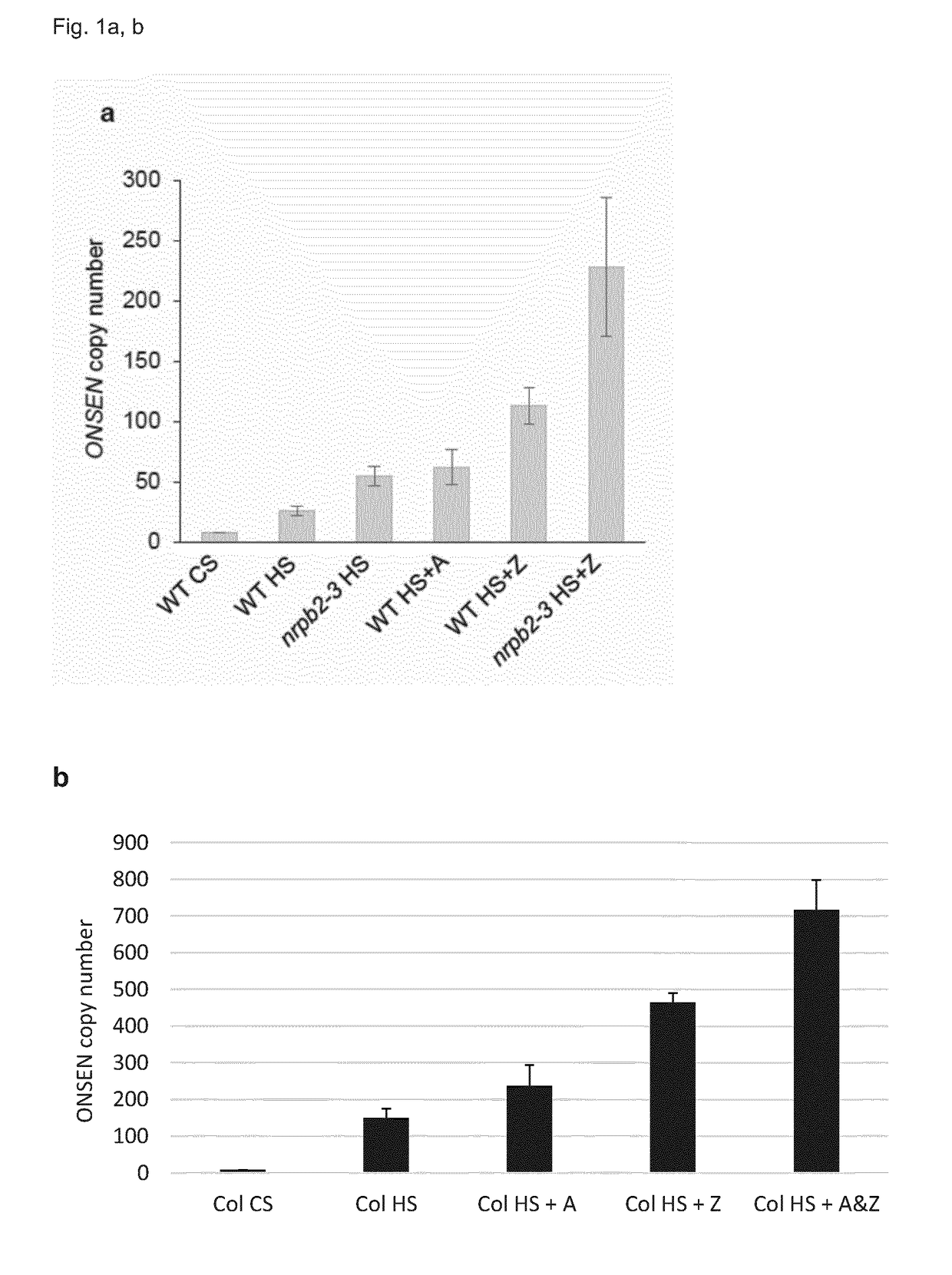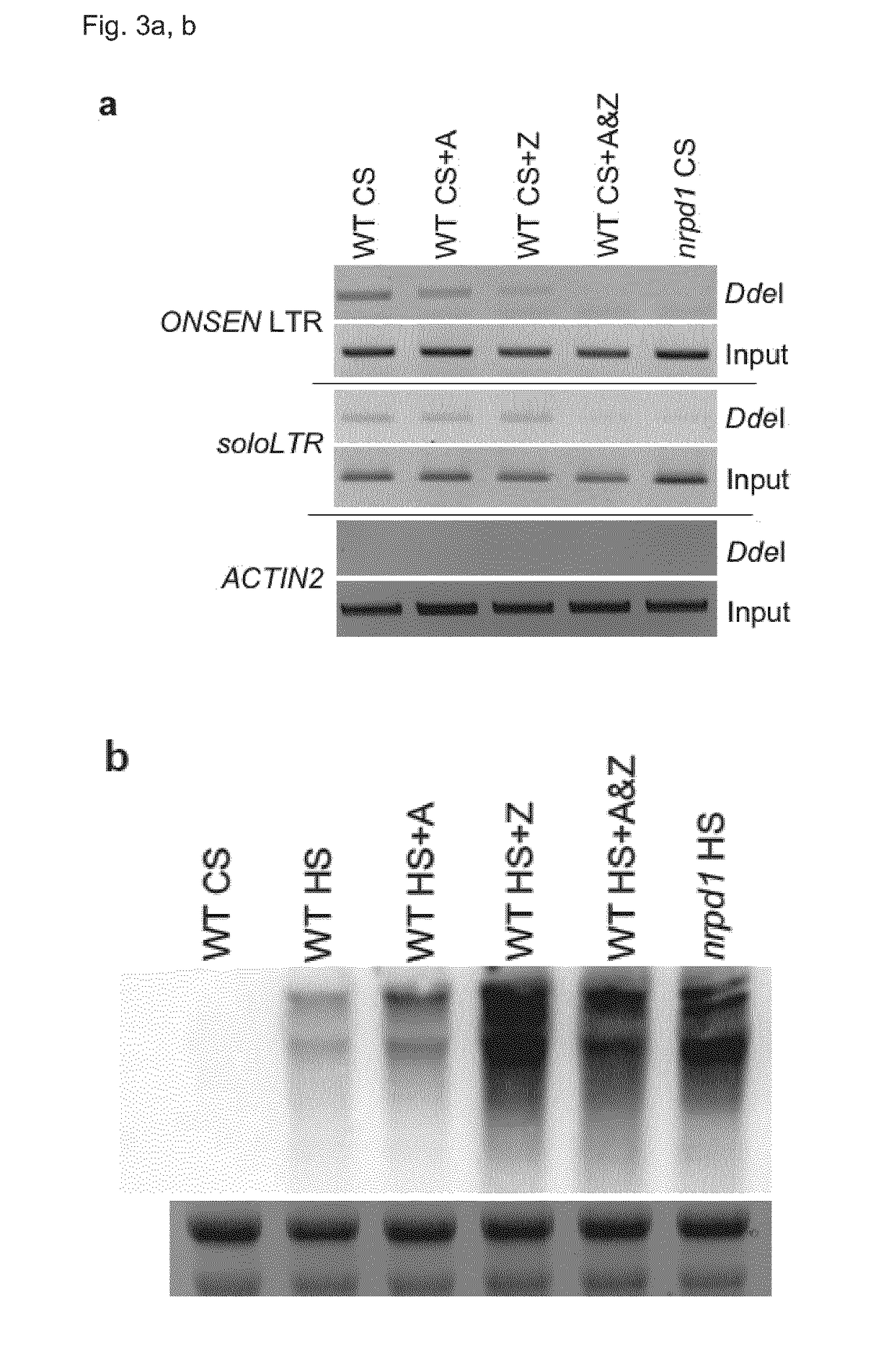Mobilisation of transposable elements to enhance genetic and epigenetic variability in a population
a technology of transposable elements and population, applied in the field of transposable element mobility, can solve the problems of limited number of active tes being used for genetic modification, limited use of organisms modified in such a manner, and few active tes currently known
- Summary
- Abstract
- Description
- Claims
- Application Information
AI Technical Summary
Benefits of technology
Problems solved by technology
Method used
Image
Examples
example 1
[0107]In order to investigate the role of Pol II on TE mobility the inventors chose the well-characterized heat-responsive copia-like ONSEN retrotransposon (Ito, H. et al., Nature, 2011, 472: 115-119) of Arabidopsis. The inventors first tested if Pol II deficient plants showed enhanced TE activity. For that purpose, the inventors took advantage of the hypomorphic nrpb2-3 mutant allele that accumulates reduced NRPB2 protein levels (Zeng, B. et al., Genes Dev, 2009, 23: 2850-2860). Using real-time PCR, it was determined that challenging nrpb2-3 seedlings by heat stress (called HS here) lead to a mild increase in ONSEN ecDNA compared to the wild type (FIG. 1a). This result was supported by the observed increase in ONSEN ecDNA after pharmacological inactivation of Pol II with 5 μg / ml α-amanitin (called A here), a potent Pol II inhibitor that does not affect Pol IV or Pol V (Haag, J. R. et al., Mol Cell, 2012, 48: 811-818) (FIG. 1a,b). Transcription by RNA Polymerase II (Pol II) is inhib...
example 2
[0108]In order to better understand the effect the drugs had at the DNA level underlying the increased activation of ONSEN after HS, the inventors assessed how they influenced DNA methylation at the long terminal repeat (LTR) of a selected ONSEN endogenous locus (AT1TE12295) and at an unrelated well characterized RdDM target (soloLTR). Treating plants with A or Z individually already resulted in reduced CHH methylation levels at the ONSEN LTR after CS (FIG. 3a). Combining the two drugs lead to a loss of DNA methylation comparable to the nrpd1 mutant. DNA methylation at the soloLTR showed a different response to the drug treatments as a reduction in DNA methylation levels was only observed in plants submitted to a combined A and Z treatment. The inventors then checked by Northern Blot whether the degree of reduction in CHH methylation would coincide with increased ONSEN-transcript-levels directly after HS. The inventors found that treatment with Z alone already resulted in the highes...
example 3
[0110]Mobilization of endogenous TEs in plants has so far been very inefficient, thus limiting their use in basic research and plant breeding. We have previously not observed ONSEN transposition in HS treated wild-type plants (Ito, H. et al. Nature, 2011, 472:115-119). Because the A&Z drug treatment resulted in an increased ONSEN ecDNA accumulation to a similar degree like in nrpd1, the inventors tested if the combined drug treatment could lead to an efficient ONSEN mobilization in wild-type plants. First, the inventors assessed by real-time PCR if, and at which frequencies, new ONSEN copies could be detected in the progeny of A&Z-treated and heat stressed plants. The inventors found new ONSEN insertions in 29.4% of the tested F1 pools (n=51) with mean copy numbers of the pools reaching up to 52 (FIG. 5). The inventors then confirmed stable novel ONSEN insertions in a subset of independent individual high copy plants by transposon display (FIG. 4a), real-time PCR (FIG. 4b) and seque...
PUM
| Property | Measurement | Unit |
|---|---|---|
| Molar density | aaaaa | aaaaa |
| Molar density | aaaaa | aaaaa |
| Molar density | aaaaa | aaaaa |
Abstract
Description
Claims
Application Information
 Login to View More
Login to View More - R&D
- Intellectual Property
- Life Sciences
- Materials
- Tech Scout
- Unparalleled Data Quality
- Higher Quality Content
- 60% Fewer Hallucinations
Browse by: Latest US Patents, China's latest patents, Technical Efficacy Thesaurus, Application Domain, Technology Topic, Popular Technical Reports.
© 2025 PatSnap. All rights reserved.Legal|Privacy policy|Modern Slavery Act Transparency Statement|Sitemap|About US| Contact US: help@patsnap.com



